Analysis of Acme National Bank of America's Disaster Recovery Plan
VerifiedAdded on 2022/08/20
|5
|1057
|13
Report
AI Summary
This report provides an analysis of Acme National Bank of America's (ANBA) disaster recovery plan (DRP). The objectives of ANBA's DRP include risk reduction, plan maintenance and testing, rapid response, and maintaining day-to-day operations during a disaster, particularly focusing on software malfunctions. The plan helps mitigate organizational risks by ensuring efficient task execution, handling system shutdowns, clarifying contact protocols, and providing a backup and recovery strategy. The report highlights the importance of DRPs for cost efficiency (preventive, detective, and corrective measures), increased employee productivity, customer retention, and better understanding of scalability, including the adoption of new technologies like cloud-based storage. It also discusses the need for tailored DRPs for different branches of multinational organizations, recognizing varying sizes and local requirements, while adhering to central guidelines. The analysis underscores the comprehensive approach to business continuity and data protection that ANBA's DRP provides.
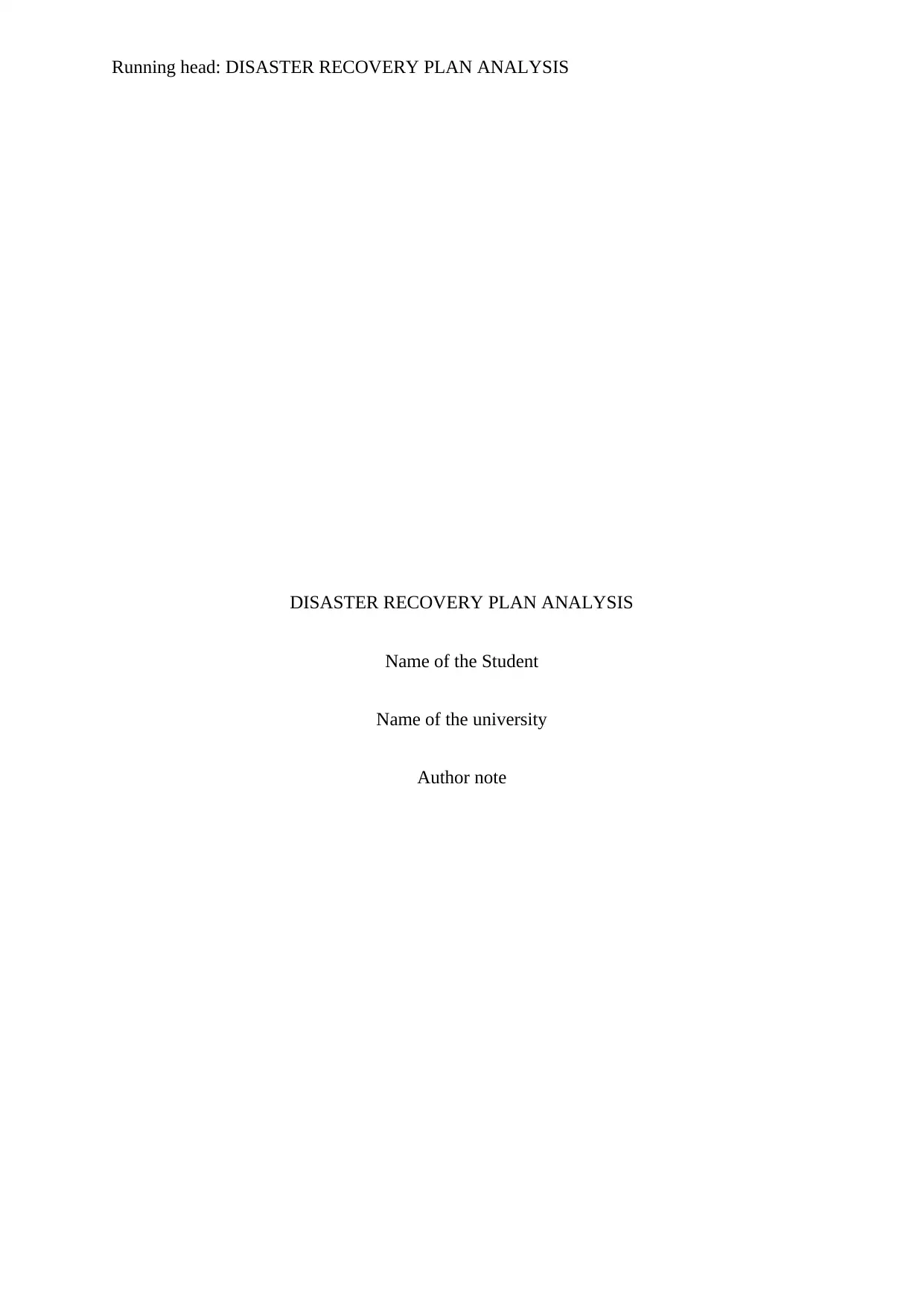
Running head: DISASTER RECOVERY PLAN ANALYSIS
DISASTER RECOVERY PLAN ANALYSIS
Name of the Student
Name of the university
Author note
DISASTER RECOVERY PLAN ANALYSIS
Name of the Student
Name of the university
Author note
Paraphrase This Document
Need a fresh take? Get an instant paraphrase of this document with our AI Paraphraser
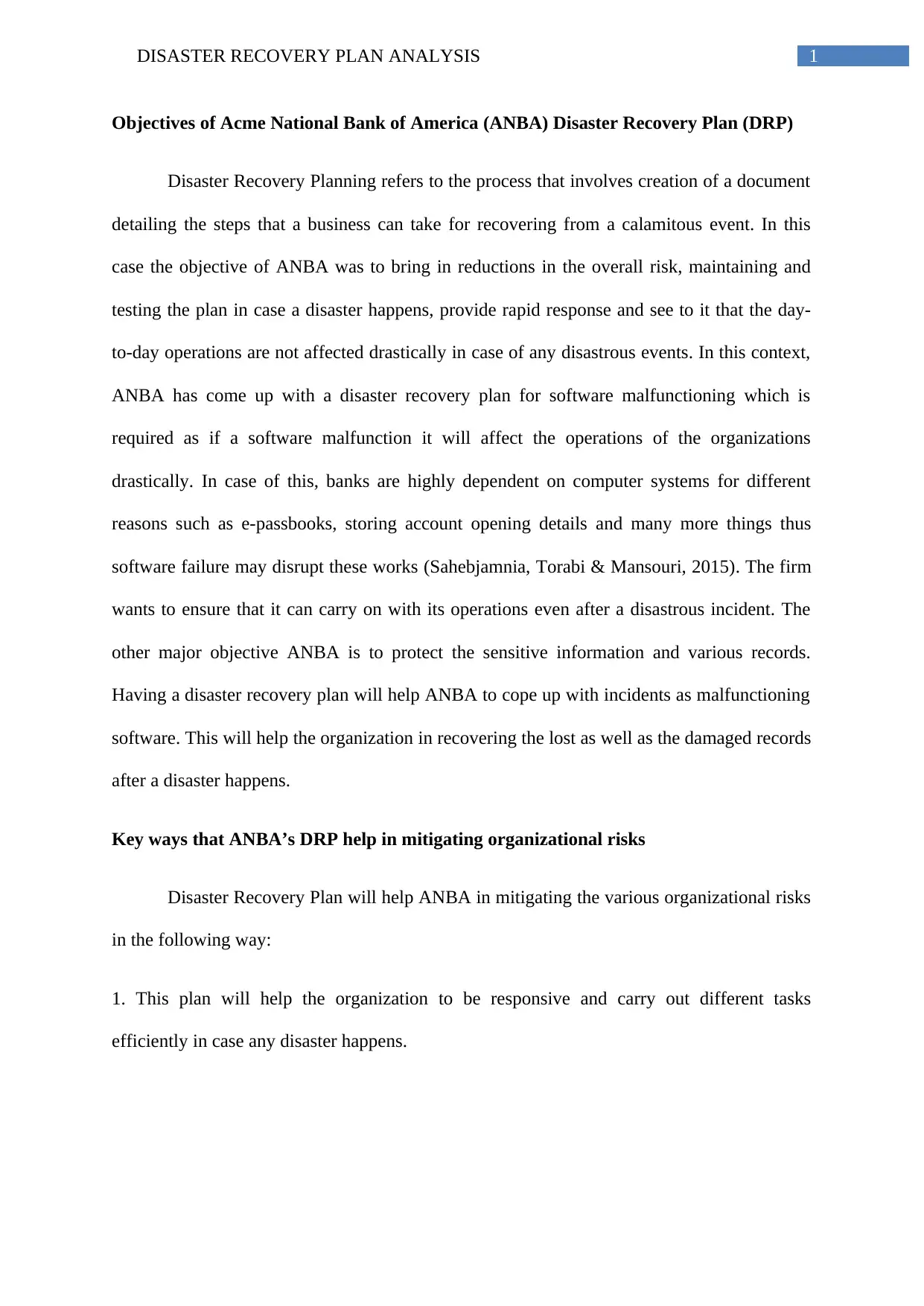
1DISASTER RECOVERY PLAN ANALYSIS
Objectives of Acme National Bank of America (ANBA) Disaster Recovery Plan (DRP)
Disaster Recovery Planning refers to the process that involves creation of a document
detailing the steps that a business can take for recovering from a calamitous event. In this
case the objective of ANBA was to bring in reductions in the overall risk, maintaining and
testing the plan in case a disaster happens, provide rapid response and see to it that the day-
to-day operations are not affected drastically in case of any disastrous events. In this context,
ANBA has come up with a disaster recovery plan for software malfunctioning which is
required as if a software malfunction it will affect the operations of the organizations
drastically. In case of this, banks are highly dependent on computer systems for different
reasons such as e-passbooks, storing account opening details and many more things thus
software failure may disrupt these works (Sahebjamnia, Torabi & Mansouri, 2015). The firm
wants to ensure that it can carry on with its operations even after a disastrous incident. The
other major objective ANBA is to protect the sensitive information and various records.
Having a disaster recovery plan will help ANBA to cope up with incidents as malfunctioning
software. This will help the organization in recovering the lost as well as the damaged records
after a disaster happens.
Key ways that ANBA’s DRP help in mitigating organizational risks
Disaster Recovery Plan will help ANBA in mitigating the various organizational risks
in the following way:
1. This plan will help the organization to be responsive and carry out different tasks
efficiently in case any disaster happens.
Objectives of Acme National Bank of America (ANBA) Disaster Recovery Plan (DRP)
Disaster Recovery Planning refers to the process that involves creation of a document
detailing the steps that a business can take for recovering from a calamitous event. In this
case the objective of ANBA was to bring in reductions in the overall risk, maintaining and
testing the plan in case a disaster happens, provide rapid response and see to it that the day-
to-day operations are not affected drastically in case of any disastrous events. In this context,
ANBA has come up with a disaster recovery plan for software malfunctioning which is
required as if a software malfunction it will affect the operations of the organizations
drastically. In case of this, banks are highly dependent on computer systems for different
reasons such as e-passbooks, storing account opening details and many more things thus
software failure may disrupt these works (Sahebjamnia, Torabi & Mansouri, 2015). The firm
wants to ensure that it can carry on with its operations even after a disastrous incident. The
other major objective ANBA is to protect the sensitive information and various records.
Having a disaster recovery plan will help ANBA to cope up with incidents as malfunctioning
software. This will help the organization in recovering the lost as well as the damaged records
after a disaster happens.
Key ways that ANBA’s DRP help in mitigating organizational risks
Disaster Recovery Plan will help ANBA in mitigating the various organizational risks
in the following way:
1. This plan will help the organization to be responsive and carry out different tasks
efficiently in case any disaster happens.
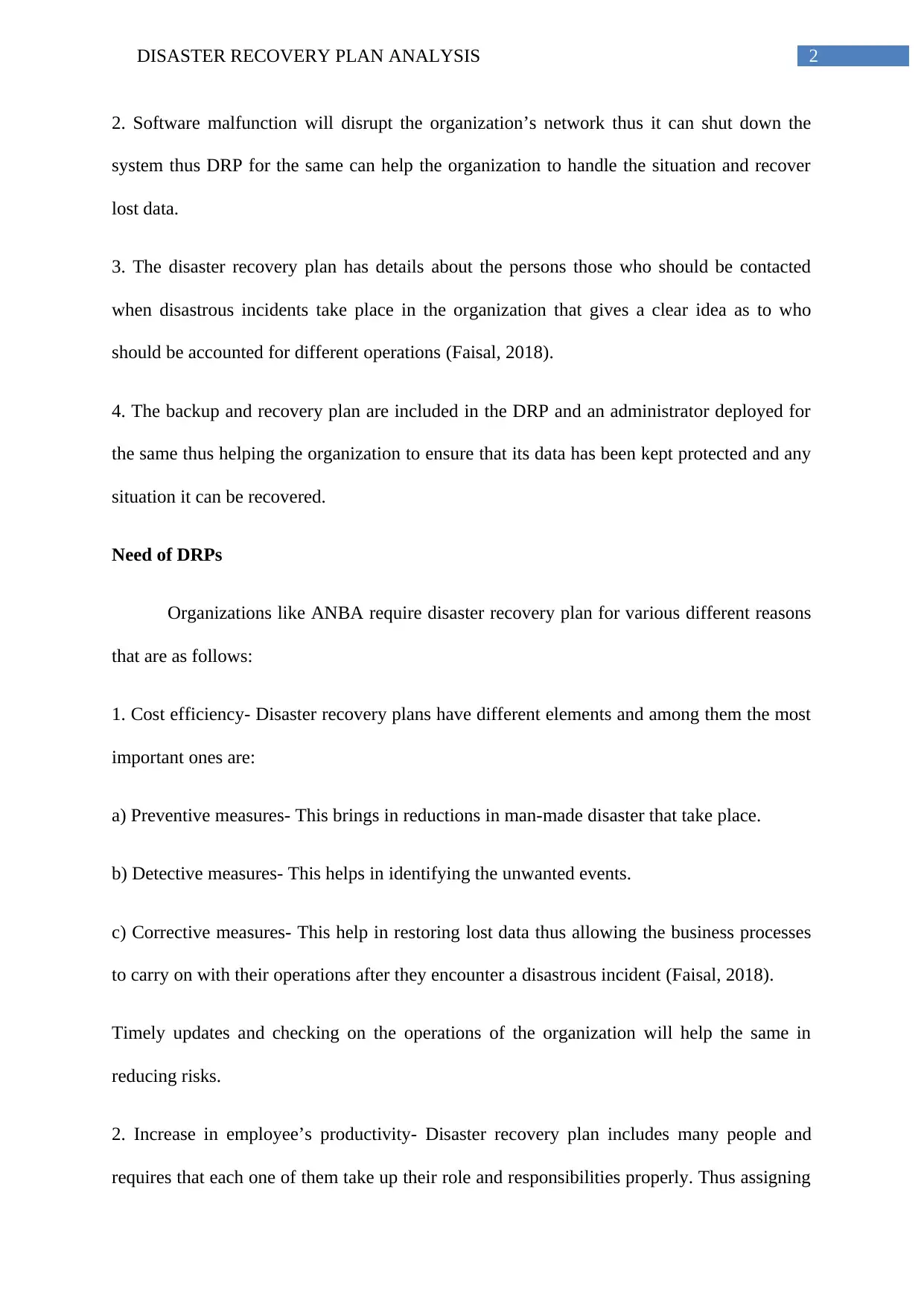
2DISASTER RECOVERY PLAN ANALYSIS
2. Software malfunction will disrupt the organization’s network thus it can shut down the
system thus DRP for the same can help the organization to handle the situation and recover
lost data.
3. The disaster recovery plan has details about the persons those who should be contacted
when disastrous incidents take place in the organization that gives a clear idea as to who
should be accounted for different operations (Faisal, 2018).
4. The backup and recovery plan are included in the DRP and an administrator deployed for
the same thus helping the organization to ensure that its data has been kept protected and any
situation it can be recovered.
Need of DRPs
Organizations like ANBA require disaster recovery plan for various different reasons
that are as follows:
1. Cost efficiency- Disaster recovery plans have different elements and among them the most
important ones are:
a) Preventive measures- This brings in reductions in man-made disaster that take place.
b) Detective measures- This helps in identifying the unwanted events.
c) Corrective measures- This help in restoring lost data thus allowing the business processes
to carry on with their operations after they encounter a disastrous incident (Faisal, 2018).
Timely updates and checking on the operations of the organization will help the same in
reducing risks.
2. Increase in employee’s productivity- Disaster recovery plan includes many people and
requires that each one of them take up their role and responsibilities properly. Thus assigning
2. Software malfunction will disrupt the organization’s network thus it can shut down the
system thus DRP for the same can help the organization to handle the situation and recover
lost data.
3. The disaster recovery plan has details about the persons those who should be contacted
when disastrous incidents take place in the organization that gives a clear idea as to who
should be accounted for different operations (Faisal, 2018).
4. The backup and recovery plan are included in the DRP and an administrator deployed for
the same thus helping the organization to ensure that its data has been kept protected and any
situation it can be recovered.
Need of DRPs
Organizations like ANBA require disaster recovery plan for various different reasons
that are as follows:
1. Cost efficiency- Disaster recovery plans have different elements and among them the most
important ones are:
a) Preventive measures- This brings in reductions in man-made disaster that take place.
b) Detective measures- This helps in identifying the unwanted events.
c) Corrective measures- This help in restoring lost data thus allowing the business processes
to carry on with their operations after they encounter a disastrous incident (Faisal, 2018).
Timely updates and checking on the operations of the organization will help the same in
reducing risks.
2. Increase in employee’s productivity- Disaster recovery plan includes many people and
requires that each one of them take up their role and responsibilities properly. Thus assigning
⊘ This is a preview!⊘
Do you want full access?
Subscribe today to unlock all pages.

Trusted by 1+ million students worldwide
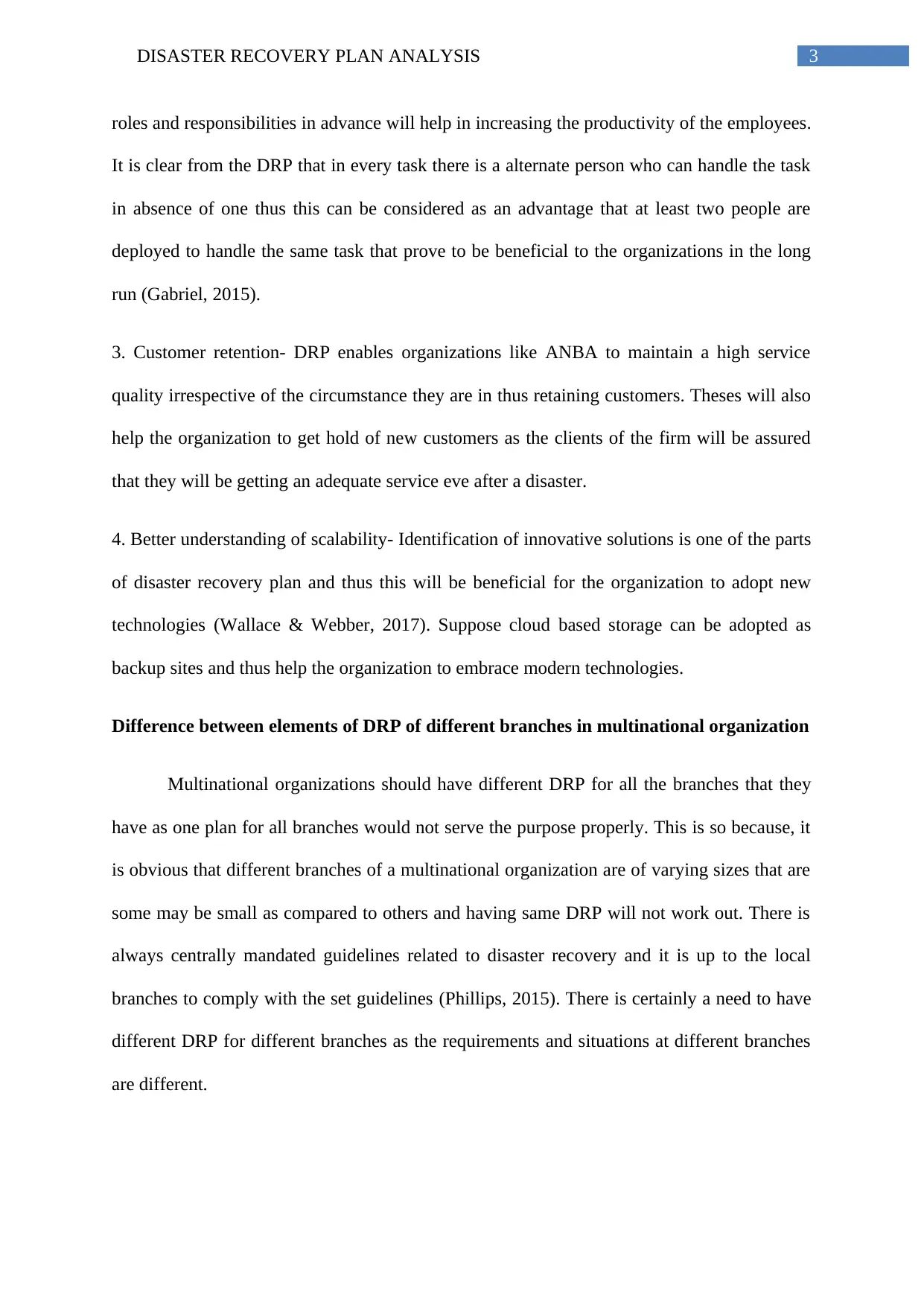
3DISASTER RECOVERY PLAN ANALYSIS
roles and responsibilities in advance will help in increasing the productivity of the employees.
It is clear from the DRP that in every task there is a alternate person who can handle the task
in absence of one thus this can be considered as an advantage that at least two people are
deployed to handle the same task that prove to be beneficial to the organizations in the long
run (Gabriel, 2015).
3. Customer retention- DRP enables organizations like ANBA to maintain a high service
quality irrespective of the circumstance they are in thus retaining customers. Theses will also
help the organization to get hold of new customers as the clients of the firm will be assured
that they will be getting an adequate service eve after a disaster.
4. Better understanding of scalability- Identification of innovative solutions is one of the parts
of disaster recovery plan and thus this will be beneficial for the organization to adopt new
technologies (Wallace & Webber, 2017). Suppose cloud based storage can be adopted as
backup sites and thus help the organization to embrace modern technologies.
Difference between elements of DRP of different branches in multinational organization
Multinational organizations should have different DRP for all the branches that they
have as one plan for all branches would not serve the purpose properly. This is so because, it
is obvious that different branches of a multinational organization are of varying sizes that are
some may be small as compared to others and having same DRP will not work out. There is
always centrally mandated guidelines related to disaster recovery and it is up to the local
branches to comply with the set guidelines (Phillips, 2015). There is certainly a need to have
different DRP for different branches as the requirements and situations at different branches
are different.
roles and responsibilities in advance will help in increasing the productivity of the employees.
It is clear from the DRP that in every task there is a alternate person who can handle the task
in absence of one thus this can be considered as an advantage that at least two people are
deployed to handle the same task that prove to be beneficial to the organizations in the long
run (Gabriel, 2015).
3. Customer retention- DRP enables organizations like ANBA to maintain a high service
quality irrespective of the circumstance they are in thus retaining customers. Theses will also
help the organization to get hold of new customers as the clients of the firm will be assured
that they will be getting an adequate service eve after a disaster.
4. Better understanding of scalability- Identification of innovative solutions is one of the parts
of disaster recovery plan and thus this will be beneficial for the organization to adopt new
technologies (Wallace & Webber, 2017). Suppose cloud based storage can be adopted as
backup sites and thus help the organization to embrace modern technologies.
Difference between elements of DRP of different branches in multinational organization
Multinational organizations should have different DRP for all the branches that they
have as one plan for all branches would not serve the purpose properly. This is so because, it
is obvious that different branches of a multinational organization are of varying sizes that are
some may be small as compared to others and having same DRP will not work out. There is
always centrally mandated guidelines related to disaster recovery and it is up to the local
branches to comply with the set guidelines (Phillips, 2015). There is certainly a need to have
different DRP for different branches as the requirements and situations at different branches
are different.
Paraphrase This Document
Need a fresh take? Get an instant paraphrase of this document with our AI Paraphraser
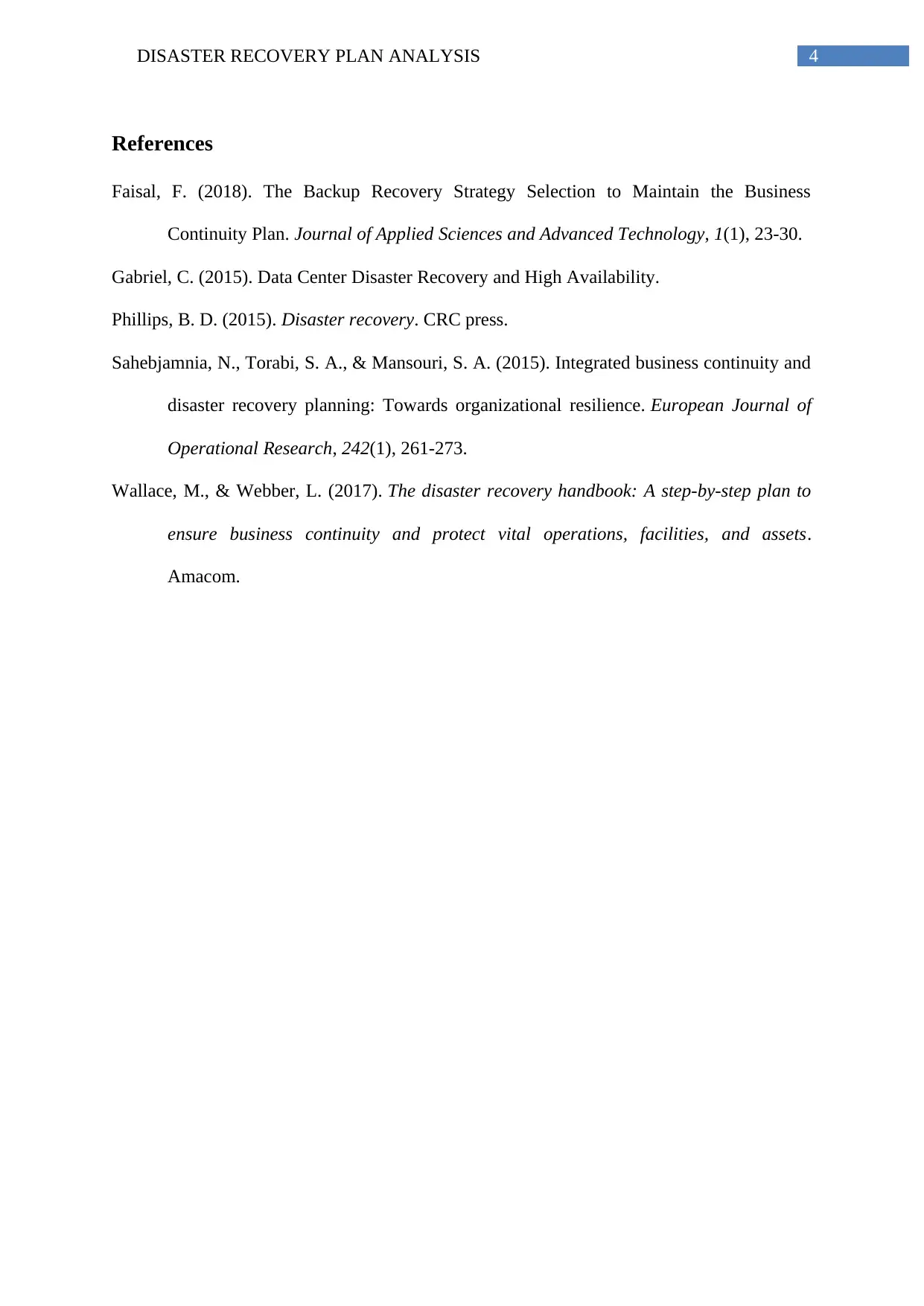
4DISASTER RECOVERY PLAN ANALYSIS
References
Faisal, F. (2018). The Backup Recovery Strategy Selection to Maintain the Business
Continuity Plan. Journal of Applied Sciences and Advanced Technology, 1(1), 23-30.
Gabriel, C. (2015). Data Center Disaster Recovery and High Availability.
Phillips, B. D. (2015). Disaster recovery. CRC press.
Sahebjamnia, N., Torabi, S. A., & Mansouri, S. A. (2015). Integrated business continuity and
disaster recovery planning: Towards organizational resilience. European Journal of
Operational Research, 242(1), 261-273.
Wallace, M., & Webber, L. (2017). The disaster recovery handbook: A step-by-step plan to
ensure business continuity and protect vital operations, facilities, and assets.
Amacom.
References
Faisal, F. (2018). The Backup Recovery Strategy Selection to Maintain the Business
Continuity Plan. Journal of Applied Sciences and Advanced Technology, 1(1), 23-30.
Gabriel, C. (2015). Data Center Disaster Recovery and High Availability.
Phillips, B. D. (2015). Disaster recovery. CRC press.
Sahebjamnia, N., Torabi, S. A., & Mansouri, S. A. (2015). Integrated business continuity and
disaster recovery planning: Towards organizational resilience. European Journal of
Operational Research, 242(1), 261-273.
Wallace, M., & Webber, L. (2017). The disaster recovery handbook: A step-by-step plan to
ensure business continuity and protect vital operations, facilities, and assets.
Amacom.
1 out of 5
Related Documents
Your All-in-One AI-Powered Toolkit for Academic Success.
+13062052269
info@desklib.com
Available 24*7 on WhatsApp / Email
![[object Object]](/_next/static/media/star-bottom.7253800d.svg)
Unlock your academic potential
Copyright © 2020–2025 A2Z Services. All Rights Reserved. Developed and managed by ZUCOL.





